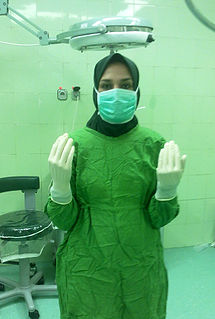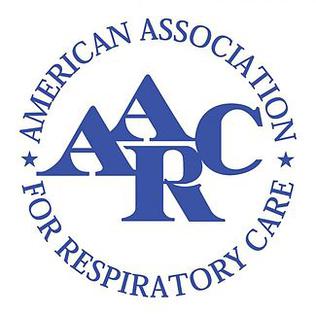Related Research Articles

A respiratory therapist is a specialized healthcare practitioner trained in critical care and cardio-pulmonary medicine in order to work therapeutically with people suffering from acute critical conditions, cardiac and pulmonary disease. Respiratory therapists graduate from a college or university with a degree in respiratory therapy and have passed a national board certifying examination. The NBRC is the not-for-profit organization responsible for credentialing the seven areas of Respiratory Therapy in the United States.

Pulmonology or pneumology is a medical specialty that deals with diseases involving the respiratory tract. It is also known as respirology, respiratory medicine, or chest medicine in some countries and areas.
Hypersomnia is a neurological disorder of excessive time spent sleeping or excessive sleepiness. It can have many possible causes and can cause distress and problems with functioning. In the fifth edition of the Diagnostic and Statistical Manual of Mental Disorders (DSM-5), hypersomnolence, of which there are several subtypes, appears under sleep-wake disorders.

A surgical technologist, also called a scrub, scrub tech, surgical technician, or operating room technician, is an allied health professional working as a part of the team delivering surgical care. Surgical technologists are members of the surgical team. The members of the team include the surgeon, surgeon's assistant, circulator nurse and anesthesia provider. They possess knowledge and skills in sterile and aseptic techniques. There are few mandatory professional requirements for surgical technologists, and the scope of practice varies widely across countries and jurisdictions. Surgical technologists attend junior colleges and technical schools, and many are trained in military schools. In the military they perform the duties of both the circulator and the scrub. The goal is for surgical technologists to be able to anticipate the next move the surgeon is going to make in order to make the procedure as smooth and efficient as possible. They do this by having knowledge of hundreds of surgical procedures and the steps the surgeon needs to take in order to complete the procedure, including the very wide range of surgical instruments they may need. Specialties can include, but are not limited to, the following: genitourinary, obstetrics and gynaecology, urology, ENT, plastics, general, orthopedics, neurology, and cardiovascular. They only work in surgical or perioperative areas and are highly specialized.
The American Academy of Sleep Medicine (AASM) is a United States professional society for the medical subspecialty of sleep medicine which includes disorders of circadian rhythms. It was established in 1975.

Sleep medicine is a medical specialty or subspecialty devoted to the diagnosis and therapy of sleep disturbances and disorders. From the middle of the 20th century, research has provided increasing knowledge and answered many questions about sleep-wake functioning. The rapidly evolving field has become a recognized medical subspecialty in some countries. Dental sleep medicine also qualifies for board certification in some countries. Properly organized, minimum 12-month, postgraduate training programs are still being defined in the United States. In some countries, the sleep researchers and the physicians who treat patients may be the same people.
The American Thoracic Society (ATS) is a nonprofit organization focused on improving care for pulmonary diseases, critical illnesses and sleep-related breathing disorders. It was established in 1905 as the American Sanatorium Association, and changed its name in 1938 to the American Trudeau Society. In 1960, it changed its name again to the American Thoracic Society. Originally the medical section of the American Lung Association, the Society became independently incorporated in 2000 as a 501 (c) (3) organization.
The American Registry for Diagnostic Medical Sonography (ARDMS), incorporated in June 1975, is an independent nonprofit organization that administers examinations and awards credentials in the areas of diagnostic medical sonography, diagnostic cardiac sonography, vascular technology, physicians’ vascular interpretation, musculoskeletal sonography and midwifery ultrasound. ARDMS has over 90,000 certified individuals in the U.S., Canada and throughout the world. ARDMS provides certifications, resources, and career information to healthcare practitioners and students practicing medical sonography.
The European Sleep Apnea Database (ESADA) is a collaboration between European sleep centres as part of the European Cooperation in Science and Technology (COST) Action B 26. The main contractor of the project is the Sahlgrenska Academy at Gothenburg University, Institute of Medicine, Department of Internal Medicine, and the co-ordinator is Jan Hedner, MD, PhD, Professor of Sleep Medicine.
Central sleep apnea (CSA) or central sleep apnea syndrome (CSAS) is a sleep-related disorder in which the effort to breathe is diminished or absent, typically for 10 to 30 seconds either intermittently or in cycles, and is usually associated with a reduction in blood oxygen saturation. CSA is usually due to an instability in the body's feedback mechanisms that control respiration. Central sleep apnea can also be an indicator of Arnold–Chiari malformation.
The Canadian Sleep Society (CSS) / Société Canadienne du Sommeil (SCS) is a professional organization with the stated aim of improving Canadians' quality of sleep. Its membership is made up of physicians, sleep researchers, polysomnographic technicians, dentists, clinical psychologists, students/trainees, and other certified allied health professionals.

The American Association for Respiratory Care (AARC) is a non profit organization and is the only professional organization supporting Respiratory Care in the United States. In addition to attempting to help lobby for beneficial legislation nationally and locally, the AARC is trying to promote the profession as a whole to increase interest and membership. The AARC began in 1943, as the Inhalation Technician Association and has evolved rapidly and repeatedly since.
The National Board for Respiratory Care (NBRC) Inc. is a non-profit organization formed in 1960 with the purpose of awarding and maintaining credentialing for Respiratory Therapists in the United States. The NBRC is the only organization in the United States which develops certification examinations for Registered Respiratory Therapists (RRTs) and Certified Respiratory Therapists (CRTs). The NBRC also offers additional specialization credentialing for respiratory practitioners that hold its certifications. The CRT and RRT designations are the standard credential in respiratory care for licensure requirements in the portions of the United States that have enacted a Respiratory Care Act. States that license respiratory therapists sometimes require the practitioner to maintain their NBRC credentialing to maintain their license to practice. The NBRC is headquartered in Overland Park, Kansas. It has been in the Kansas City metropolitan area since 1974. The NBRC is located at 10801 Mastin St, Suite 300, Overland Park, KS 66210.
A polysomnographic technologist performs overnight, daytime, or home sleep studies, polysomnograms, on people with suspected sleep disorders. In the United States and worldwide, the process for becoming a polysomnography technician or technologist is primarily either on-the-job or certificate based. There are associate level programs offered by for-profit schools that award a degree in polysomnography technology in the United States, though not necessary to attain employment with the same title. After an education program or adequate on-the-job training is complete, the student is eligible for credentialing by the Board of Registered Polysomnographic Technologists (BRPT), a non-profit credentialing agency based in the United States but serving polysomnographers worldwide. The BRPT maintains credentialing for over 35 countries including Canada and the United States as well as over 17,000 individuals working in the industry.
The Board of Registered Polysomnographic Technologists (BRPT) maintains credentialing for polysomnographic technologists. It offers two credentials, the registered and certified polysomnographic technologist credentials. The BRPT is located at: 8400 Westport Drive, 2nd Floor, McLean, Virginia 22102. The BRPT was established in 1978 and offered the first RPSGT exam in 1979.
The American Board of Sleep Medicine (ABSM) is a nonprofit organization that certifies physicians, PhDs, specialists, and technologists in the specialty of sleep medicine. ABSM shares office space and at least some staff with the American Academy of Sleep Medicine (AASM) in Darien, Illinois, USA; the two organizations are closely related and serve basically the same constituency.
A Sleep disorder specialist (SDS) is a Registered Respiratory Therapist (RRT-SDS) that has successfully passed the certification examination NBRC-SDS. The respiratory therapist may also be a Certified Respiratory Therapist (CRT-SDS) under certain conditions. The sleep disorder specialist scores and performs polysomnography and also assists in diagnosing and preparing a treatment plan for the condition. Some of the conditions the sleep disorder specialist helps evaluate and treat are; insomnia, sleep apnea, restless legs syndrome, and narcolepsy.
The Clinical Sleep Educator (CSE) certificate was established by the Board of Registered Polysomnographic Technologists (BRPT) in 2012. The role of the CSE, is to communicate "with patients, families, and the community to educate individuals on sleep disorders, good sleep hygiene, ways to optimize treatment, methods to improve and monitor compliance with prescribed treatment, and in general assists patients in eliminating barriers to care in order to maximize their quality of life." This program is not to be confused with another program to be launched by the BRPT in 2014, the Clinical Sleep Health Examination.
The American Association of Neuromuscular & Electrodiagnostic Medicine (AANEM) is a medical society for the medical subspecialty of neuromuscular and electrodiagnostic medicine based in the United States. Members are primarily neurologists and physiatrists—as well as allied health professionals and PhD researchers.
The British Sleep Society (BSS) was established in 1988 to support clinicians, researchers, nurses, technologists, scientists and students with an interest in sleep and sleep disorders. It acts as an umbrella organisation, with a number of roles and activities. The Society advises health services policy through submitting evidence for consideration by the National Institute for Health and Care Excellence (NICE). It organises an influential scientific meeting each year dedicated to sleep disorders and sleep research and jointly hosts an annual international education course for sleep technologists and clinicians. The Society has charitable status, and operates throughout England, Wales, Northern Ireland and Scotland. It serves the media, fund raisers, commerce and concerned members of the public with support and advice.
References
- ↑ Kistner, Cindy (June 2011). "AAST Membership Report (N.p.)". aastweb.org. AAST. p. 4. Retrieved 2019-01-29.
- ↑ Lee-Chiong MD, Teofilo (2007). Fundamentals of Sleep Technology. Lippincott Williams & Wilkins. ISBN 978-0781792875.
- ↑ Waring, C (January 7, 2009). "American Association of Sleep Technologists - APT: Description". Healthfinder.gov. U.S. Department of Health and Human Services. Retrieved 2019-01-29.
- ↑ "American Association of Sleep Technologists (AAST)". sleepreviewmag.com. Sleep Review. 2013. Archived from the original on 2013-09-06. Retrieved 2013-09-06.
- ↑ Kistner, Cindy (June 2011). "AAST Membership Report (N.p.)". aastweb.org. AAST. p. 8. Retrieved 2019-01-29.
- 1 2 Kistner, Cindy (June 2011). "AAST Membership Report (N.p.)". aastweb.org. AAST. pp. 2, 5. Retrieved 2019-01-29.